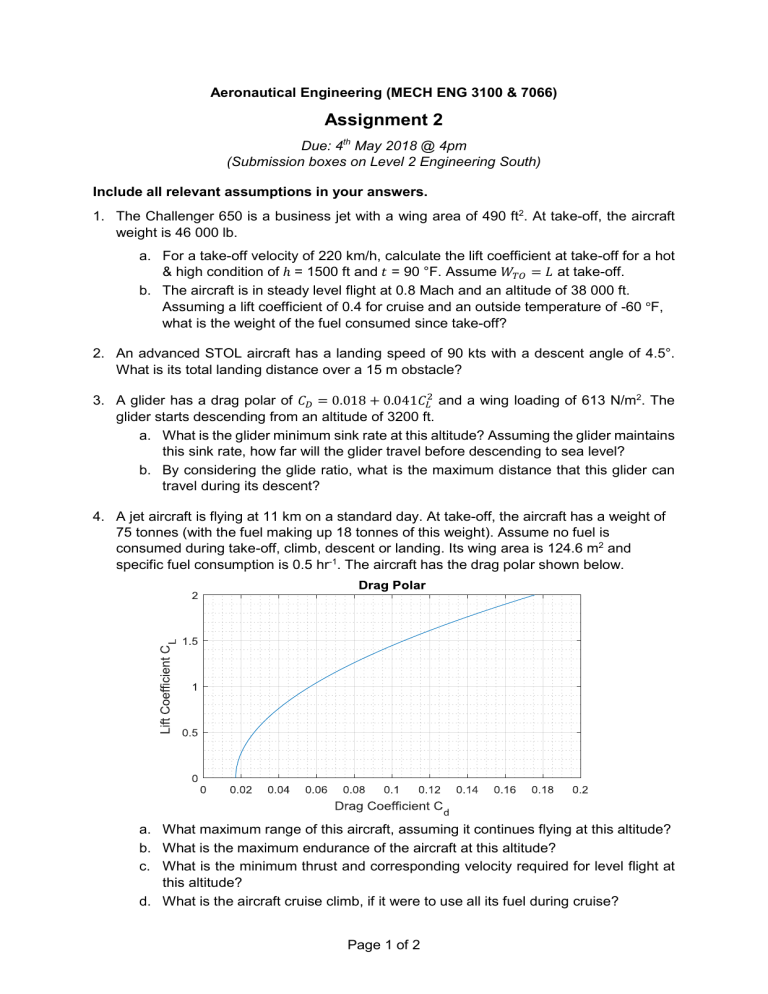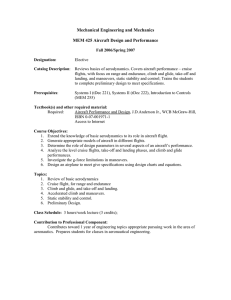
Aeronautical Engineering (MECH ENG 3100 & 7066) Assignment 2 Due: 4th May 2018 @ 4pm (Submission boxes on Level 2 Engineering South) Include all relevant assumptions in your answers. 1. The Challenger 650 is a business jet with a wing area of 490 ft2. At take-off, the aircraft weight is 46 000 lb. a. For a take-off velocity of 220 km/h, calculate the lift coefficient at take-off for a hot & high condition of ℎ = 1500 ft and 𝑡 = 90 °F. Assume 𝑊𝑇𝑂 = 𝐿 at take-off. b. The aircraft is in steady level flight at 0.8 Mach and an altitude of 38 000 ft. Assuming a lift coefficient of 0.4 for cruise and an outside temperature of -60 °F, what is the weight of the fuel consumed since take-off? 2. An advanced STOL aircraft has a landing speed of 90 kts with a descent angle of 4.5°. What is its total landing distance over a 15 m obstacle? 3. A glider has a drag polar of 𝐶𝐷 = 0.018 + 0.041𝐶𝐿2 and a wing loading of 613 N/m2. The glider starts descending from an altitude of 3200 ft. a. What is the glider minimum sink rate at this altitude? Assuming the glider maintains this sink rate, how far will the glider travel before descending to sea level? b. By considering the glide ratio, what is the maximum distance that this glider can travel during its descent? 4. A jet aircraft is flying at 11 km on a standard day. At take-off, the aircraft has a weight of 75 tonnes (with the fuel making up 18 tonnes of this weight). Assume no fuel is consumed during take-off, climb, descent or landing. Its wing area is 124.6 m2 and specific fuel consumption is 0.5 hr-1. The aircraft has the drag polar shown below. a. What maximum range of this aircraft, assuming it continues flying at this altitude? b. What is the maximum endurance of the aircraft at this altitude? c. What is the minimum thrust and corresponding velocity required for level flight at this altitude? d. What is the aircraft cruise climb, if it were to use all its fuel during cruise? Page 1 of 2 5. An aircraft with a wing area of 21 m2 and wingspan of 13.45 m is taking off in SSL conditions. Assume the wings are approximately rectangular and the transitional Reynolds number is 5.5 x 105. Calculate the skin friction drag at the moment when the aircraft is moving at a velocity of 30 km/hr. 6. An Airbus A400M is performing a tactical airlift mission. The aircraft has a wing planform area of 2420 ft2 and weighs 240 000 lb at take-off. The aircraft is powered by four turboprop engines which can produce a maximum of 11 000 hp each. Assume a propeller efficiency of 90%. a. The aircraft takes off at 123 kts from a dirt runway at SSL conditions. Calculate the take-off distance required. Assume 𝐶𝐿 𝑚𝑎𝑥 = 2.0, 𝐶𝐷0 = 0.04 and maximum engine power at take-off. b. The aircraft climbs quickly and steadily to an altitude of 31 000 ft. During climb, the velocity is 230 kts, drag coefficient is 0.028 and the engines operate at 72% maximum capacity. Calculate the rate of climb and the corresponding angle of climb for these conditions. Ignore the weight of the fuel lost during climb and use an average density value for your calculations. c. Halfway through the mission, the aircraft drops 50 000 lb of cargo. Assuming the aircraft was flying at 𝐿/𝐷𝑚𝑎𝑥 before the airdrop, should the aircraft fly faster or slower to maintain 𝐿/𝐷𝑚𝑎𝑥 afterwards? 7. A twin-engined aircraft modelled after the Piper PA-34 Seneca is flying through a standard atmosphere at 7000 m. Assume the engine power is proportional to density ratio, i.e. 𝑃ℎ = 𝑃0 𝜎. The aircraft has the following characteristics: 𝑊 = 2150 kg 𝑆 = 19.4 m2 𝑏 = 11.9 m 𝑒 = 0.80 𝐶𝐷0 = 0.026 𝑃𝑚𝑎𝑥,𝑆𝑆𝐿 = 220 hp 𝜂𝑝𝑟𝑜𝑝 = 0.87 a. What is the maximum velocity that the aircraft can achieve at this altitude? b. What is the minimum power required at this altitude? c. Calculate and plot the power required curve at the given altitude (at least 5 values must be calculated). Show the values calculated in parts (a) and (b) on your graph. 8. A long, round cylinder has a diameter of 120 mm and length of 800 mm. The cylinder is placed in a flow with velocity of 60 m/s at SSL. The length of the cylinder is perpendicular to the direction of airflow. a. Calculate the form drag on the cylinder if: 𝐶𝐷 = 1.2 where Re < 300 000 𝐶𝐷 = 0.4 where Re >300 000 b. To reduce drag, a streamlined fairing is wrapped around the cylinder. Calculate the form drag if, for the streamlined fairing: 𝐶𝐷 = 0.5 where Re < 300 000 𝐶𝐷 = 0.1 where Re > 300 000 Page 2 of 2


